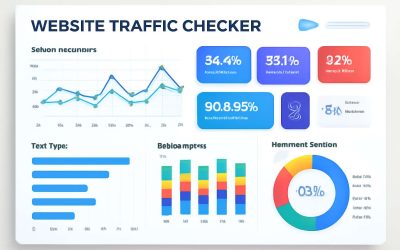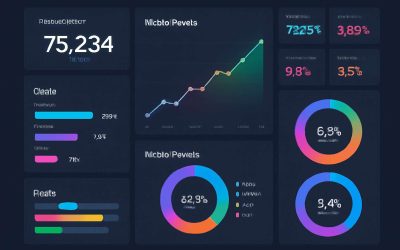Understanding Google Analytics for Website Traffic
What Is Google Analytics and Why Is It Essential?
Understanding Google Analytics is akin to deciphering the silent language of your website visitors. It reveals the unseen currents that shape your online presence, offering a window into the real-time ebb and flow of website traffic google analytics tracks. This tool isn’t just about numbers; it’s about uncovering the stories behind each visit—what draws users in, what keeps them engaged, and ultimately, what prompts them to leave.
Why is it essential? Because without this deep awareness, your website is merely a vessel adrift in a vast digital ocean. Google Analytics transforms raw data into meaningful insights, allowing you to tune your strategy with precision. From visitor behaviour to conversion pathways, every detail becomes a piece of the larger puzzle. Consider these core facets of website traffic google analytics helps illuminate:
- User demographics and behaviour patterns
- Top-performing content and pages
- Traffic sources and referral paths
In essence, Google Analytics isn’t just a tool—it’s an introspective lens into human interaction with your digital domain. Without it, understanding your audience remains guesswork; with it, insight becomes power, and strategy, inevitability.
Key Metrics to Track in Website Traffic Analysis
Understanding Google Analytics for website traffic entails more than just glancing at numbers; it’s about deciphering the subtle cues that reveal how visitors interact with your site. Key metrics such as bounce rate and session duration serve as vital indicators, painting a vivid picture of user engagement and content relevance.
By analysing these elements, you gain insights into which pages captivate your audience and which ones fall flat. For example, a high bounce rate might hint at disconnects in your content strategy or user experience. Meanwhile, tracking traffic sources helps you identify where your visitors are coming from—be it search engines, social media, or referral links—offering clues to optimise your outreach.
In essence, understanding these core metrics within website traffic google analytics transforms raw data into a strategic advantage, guiding your efforts with precision and clarity.
How Google Analytics Works: An Overview
Understanding how Google Analytics functions is akin to deciphering the heartbeat of your digital presence. This powerful tool doesn’t merely record raw numbers; it translates complex user interactions into meaningful insights. At its core, Google Analytics tracks website traffic, providing a window into visitor behaviour that can reveal underlying patterns and preferences. It’s fascinating how a handful of metrics can illuminate the subtleties of user engagement and content resonance.
When delving into the mechanics of Google Analytics, it operates through a simple yet sophisticated process. A small tracking code, embedded within your website, acts as a silent observer, collecting data about each visitor’s journey. This data is then processed in real-time, allowing you to see which channels drive traffic, how visitors navigate your pages, and where they tend to exit. The beauty of website traffic google analytics lies in its ability to turn seemingly mundane numbers into a strategic narrative—one that guides content optimisation and outreach efforts.
To better understand this ecosystem, consider the following key elements that make up website traffic google analytics:
- Tracking Visitor Sources: Whether visitors arrive via organic search, social media, or referral links, the data reveals where your outreach is most effective.
- Monitoring Behaviour Flows: Visualising how users move through your site uncovers content that captivates or confuses your audience.
- Assessing Engagement Metrics: Metrics like session duration and bounce rate shed light on how compelling and relevant your content truly is.
In essence, Google Analytics acts as both a mirror and a compass—reflecting your current performance while guiding future strategies with clarity and precision. It’s a vital ally in the ongoing quest to optimise website traffic and foster authentic engagement.
Setting Up Google Analytics for Your Website
Creating and Configuring Your Google Analytics Account
Embarking on the journey to unlock the secrets of website traffic google analytics begins with a single, decisive step: setting up your account. Imagine your digital footprint as a map waiting to be charted—each visitor, click, and bounce a vital sign of your online presence. Creating and configuring your Google Analytics account transforms raw data into a symphony of insights, guiding your strategy with clarity and purpose.
First, visit the Google Analytics portal and sign in with your Google account. From there, you will be prompted to create a new property—your digital vessel—by entering your website’s details. As you proceed, it’s essential to select the correct data-sharing options, ensuring your analytics are both comprehensive and secure. To streamline this process, consider these steps:
- Assign a clear and descriptive name to your property.
- Input your website’s URL precisely, including the correct protocol (http or https).
- Configure your data streams—whether web or app—tailoring the setup to the nature of your traffic.
With your property established, the next crucial phase involves adding a tracking code—an almost poetic snippet of JavaScript—that acts as a silent sentinel, capturing all website traffic google analytics encounters. Placing this code within your website’s header ensures seamless data collection, illuminating visitor behaviour and engagement like stars in the night sky.
Implementing Tracking Codes and Cookies
Getting started with website traffic google analytics isn’t just about adding a few lines of code and hoping for the best. It’s akin to planting a seed—careful preparation ensures your digital garden blooms with insights. The moment you embed the tracking code, a silent observer begins its tireless vigil, capturing every visitor, click, and bounce with meticulous precision. But beware—placing this JavaScript snippet in the wrong spot is like planting it upside down; your data will be skewed and less useful. Ensuring it sits within your website’s header guarantees seamless data collection, revealing the behaviour of your visitors as they navigate your site.
To streamline your setup, consider these steps:
- Double-check that the tracking code matches your Google Analytics property.
- Place it in the header section for optimal coverage.
- Test the implementation using real-time reports to confirm data flow.
Cookies also play a pivotal role, acting as behavioural breadcrumbs that help identify returning visitors and personalise their experience. They’re the unsung heroes of website traffic google analytics, quietly working behind the scenes to paint a detailed picture of user engagement. When correctly configured, cookies ensure your analytics aren’t just numbers, but stories of your audience’s digital journey—each click a chapter, each bounce a plot twist.
Verifying Proper Data Collection
Setting up Google Analytics to verify proper data collection is a vital step in understanding your website’s true potential. When done correctly, it transforms raw numbers into meaningful stories about your audience’s journey. A common pitfall is rushing through the process without confirming that data flows as it should. To avoid this, once your tracking code is in place, it’s wise to utilise the real-time reports feature. This allows you to see live visitors navigating your site, ensuring your setup is functioning seamlessly.
A simple yet effective method involves checking the following:
- Open your website in a new tab or window.
- Navigate through different pages to simulate user behaviour.
- Observe the real-time report to verify visitor activity appears instantly.
If you see activity, congratulations—your website traffic google analytics setup is on the right track. If not, re-examining the placement of your tracking code can often resolve the issue. This diligent approach ensures every click, bounce, and visitor is accurately captured, giving you the clarity needed to grow and adapt.
Analyzing Website Traffic Data
Audience Insights: Visitors Demographics and Interests
Within the vast labyrinth of digital pathways, understanding the true essence of your visitors becomes akin to deciphering an ancient, mystical code. Google Analytics reveals fascinating insights into your audience, transforming raw website traffic data into a living tapestry of human stories. By exploring visitors’ demographics and interests, one can unlock hidden chambers of behavioural patterns that influence your site’s success.
Imagine peering through a crystal ball, where age, gender, location, and even interests shimmer vividly, guiding your strategic decisions. Audience insights in Google Analytics provide this clarity, offering a panoramic view of who your visitors are and what they seek. To truly harness this power, consider the following aspects:
- Age and gender: Knowing the core demographic helps tailor content that resonates deeply.
- Geographical data: Localised insights enable localisation strategies that captivate regional audiences.
- Interests and affinities: Understanding what your visitors care about fosters targeted marketing efforts.
Such detailed information enhances the ability to craft personalised experiences, ultimately transforming mere website traffic into meaningful engagement. With Google Analytics illuminating these facets, website owners can navigate the intricate currents of their audience’s desires with confidence and precision.
Acquisition Channels: Understanding Traffic Sources
Understanding the origins of your website traffic is like decoding a complex symphony; each source contributes a unique note to the overall melody. Google Analytics offers an intricate map of traffic sources, revealing whether visitors arrive via organic search, paid campaigns, social media, or direct visits. This real-time data provides invaluable insight into which channels are driving engagement and conversions.
By analysing traffic acquisition channels, you gain a clearer picture of your audience’s behaviour and preferences. For instance, organic search may indicate a strong SEO strategy, while a surge in referral traffic could highlight successful partnerships or content outreach. Recognising these patterns allows website owners to refine their marketing efforts with precision and purpose.
- Organic Search
- Paid Advertising
- Social Media Platforms
- Referral Links from Other Websites
- Direct Traffic (Type-in or Bookmarked)
This layered understanding of website traffic google analytics unlocks a deeper awareness of how users find and interact with your site, transforming raw data into strategic action. Tracking these channels consistently reveals the nuanced symphony of digital engagement, guiding your optimisation journey with clarity and confidence.
Behavior Flow: User Navigation Patterns
Understanding how visitors traverse your website transforms raw data into a vivid tableau of user intent and behaviour. Analyzing website traffic Google Analytics reveals intricate navigation patterns that often mirror the subconscious cues guiding each visitor’s journey. These pathways—subtle, meandering, sometimes abrupt—are etched into behavioural flow reports, exposing moments where engagement peaks or falters.
By scrutinising these patterns, you can discern whether users are moving seamlessly from homepage to product pages or bouncing prematurely after a single click. For instance, a high drop-off rate after the initial landing might signal a disconnect between expectations and content. Conversely, a steady flow towards conversion points indicates a compelling user experience.
- Entry points that lead to sustained engagement
- Common pathways that culminate in conversion or exit
- Unanticipated detours revealing potential content gaps
Each element of the user navigation pattern tells a story—one that, when read correctly, empowers you to fine-tune your SEO and content strategies. Mastering these behavioural flows within the realm of website traffic Google Analytics elevates your understanding from surface-level metrics to a profound comprehension of your audience’s subconscious digital choreography.
Conversions and Goals Tracking
Tracking conversions and setting goals within Google Analytics transforms raw website traffic data into actionable insights. When visitors complete desired actions—whether making a purchase, signing up for a newsletter, or downloading a resource—these events become measurable milestones that signal success or reveal bottlenecks. By meticulously analysing these conversions, you gain a clearer picture of your website’s effectiveness and areas ripe for optimisation.
Utilising website traffic Google Analytics to monitor goal completions allows you to identify the most fruitful pathways leading to conversions. It also highlights points where users drop off, revealing content gaps or usability issues that may hinder progress. For example, dissecting the journey from landing page to checkout can uncover friction points, enabling targeted improvements to streamline the user experience.
- Define clear conversion goals aligned with your business objectives.
- Implement tracking codes on key pages and actions.
- Analyse the conversion funnels to pinpoint where users abandon their journey.
- Refine content and user pathways based on behavioural insights.
By harnessing these insights, you not only optimise your website’s performance but also deepen your understanding of your audience’s digital behaviour—making every click a step closer to meaningful engagement.
Optimizing Website Performance with Google Analytics Data
Identifying High-Performing Content
Unlocking the true potential of your website starts with understanding what drives visitors and keeps them engaged. Google Analytics provides a wealth of data that can be transformed into strategic insights. By analysing website traffic Google Analytics reveals which content resonates most with your audience, helping you identify high-performing pages. These pages often act as magnets, attracting the bulk of your traffic and generating conversions.
Focusing on these top performers allows you to optimise your content strategy effectively. For example, you might find that blog posts containing specific keywords or formats perform exceptionally well. Recognising these patterns enables targeted improvements, such as enhancing readability or boosting internal linking. In the end, leveraging detailed insights from website traffic Google Analytics ensures your website remains competitive and engaging.
Reducing Bounce Rates and Improving Engagement
Imagine slashing your bounce rate while turning casual visitors into loyal fans—sounds like magic? Well, with website traffic Google Analytics, it’s more like turning data into a digital wizard’s wand. By analysing user engagement metrics, you can pinpoint exactly where visitors drift away or linger longer, offering a goldmine of insights for optimisation. Instead of guessing which pages need sprucing up, you get clear answers, helping you craft tailored content that captivates.
To truly optimise website performance, consider focusing on these key areas:
- Streamlining page load times to keep impatient browsers hooked
- Enhancing call-to-action placements based on behavioural flow data
- Refining content layout to improve readability and user experience
Understanding user navigation patterns allows you to reduce bounce rates and boost engagement effortlessly. After all, a well-optimised website isn’t just about attracting visitors; it’s about keeping them enchanted—thanks to the strategic insights unlocked through website traffic Google Analytics.
Enhancing User Experience Based on Traffic Insights
Optimising website performance hinges on understanding how visitors interact with your site. With insights gleaned from website traffic Google Analytics, you can fine-tune the user experience to keep visitors engaged. By analysing real-time data, you quickly identify bottlenecks that slow down your site or pages that cause visitors to bounce away. Enhanced user experience isn’t just about aesthetics; it’s about delivering seamless navigation and relevant content where it matters most.
For example, behavioural flow reports reveal exactly which paths users take and where they tend to drop off. This allows you to make precise adjustments, such as improving page load speeds or repositioning call-to-action buttons for maximum impact. Sometimes, small tweaks—like simplifying content layout or reducing clutter—can make a big difference in engagement rates. When website traffic Google Analytics provides these granular insights, transforming data into strategic action becomes effortless.
In the end, a data-driven approach ensures your website remains fast, intuitive, and compelling—turning casual visitors into loyal customers. Leveraging traffic insights allows you to craft a streamlined experience that keeps users returning, boosting your overall digital footprint and SEO performance.
Segmenting Traffic for Targeted Improvements
Imagine having a secret weapon that reveals exactly which parts of your website are thriving and which are dragging your digital performance down. That’s precisely what segmenting traffic with Google Analytics offers. By dividing your website traffic Google Analytics data into targeted groups—such as new visitors versus returning customers or mobile users versus desktop browsers—you can pinpoint where to focus your optimisation efforts. This granular approach transforms broad brushstrokes into fine-tuned adjustments, making your website more responsive to user needs.

For example, if data shows a high bounce rate amongst mobile visitors, it might be time to prioritise mobile optimisation. Conversely, identifying that desktop users are engaging more with certain content allows you to craft a tailored experience that boosts conversion rates. To streamline your efforts, consider creating custom segments that reflect your audience’s behaviour patterns, enabling targeted improvements that elevate overall site performance. This strategic segmentation is the secret sauce in maximising the impact of your website traffic google analytics insights.

Advanced Google Analytics Features for Traffic Analysis
Custom Dashboards and Reports
Harnessing the full potential of Google Analytics transforms raw data into a tapestry of insights, illuminating the unseen corridors of your website traffic. Advanced Google Analytics features unlock this treasure trove, allowing marketers and website owners to craft customised dashboards that serve as their own crystal balls, revealing patterns and trends with crystal-clear precision. Imagine visualising your website traffic Google Analytics data in a way that instantly highlights the sources of your most engaged visitors or the pages that act as gateways to conversions.
Custom reports elevate this process further, enabling you to tailor metrics and dimensions to align perfectly with your business goals. By integrating features such as custom segments and secondary dimensions, you can dissect traffic with surgical accuracy. For instance, tracking specific user interactions across multiple devices or pinpointing the precise journey of high-value visitors becomes effortless. This granular level of analysis ensures your strategies are rooted in data-driven clarity, transforming your website traffic insights into a strategic advantage that propels growth and engagement.
Event Tracking and Real-Time Data
In a digital landscape where attention spans are fleeting and competition fierce, harnessing the full potential of Google Analytics becomes not just advantageous but essential. Advanced features like event tracking and real-time data unlock unprecedented insights into website traffic Google Analytics, transforming passive numbers into active intelligence. Event tracking, for instance, allows you to monitor specific user interactions—be it clicks, video plays, or downloads—offering a granular view of how visitors engage with your site. This level of detail reveals the unseen drivers behind traffic patterns and user behaviour.
Real-time data pushes this understanding further, providing instant feedback on how visitors navigate your website at any given moment. With live dashboards, you can observe spikes in traffic, emerging interests, or potential issues as they happen—making it possible to respond swiftly and optimise user experience dynamically. Imagine being able to see, in real-time, which campaigns are driving the most traffic or which pages are causing bounce rates to spike. These insights sharpen your strategic edge, ensuring your website traffic Google Analytics remains a powerful tool for growth and innovation.
Using Google Tag Manager for Enhanced Tracking
In the ever-evolving theatre of digital marketing, leveraging advanced Google Analytics features can turn your website into a well-oiled performance. Among these, using Google Tag Manager (GTM) for enhanced tracking stands out as a masterstroke, enabling you to capture intricate details of user interaction without breaking a sweat. This sophisticated tool simplifies the deployment of tracking codes, ensuring your website traffic Google Analytics data remains both precise and comprehensive.
By integrating GTM, you gain control over an arsenal of tags that can monitor a plethora of user actions—clicks, scrolls, form submissions, and beyond. A strategic implementation might involve setting up triggers that fire when a visitor interacts with a specific element or reaches a certain part of a page. The beauty of this approach lies in its flexibility; you can tailor your tracking to follow the unique behaviour of your audience, providing an enriched tapestry of insights that standard analytics might overlook.
For a more organised approach, consider this
- layered setup:
- custom event creation,
- precise trigger configurations,
- and detailed dataLayer variables.
These elements work in concert, offering a granular view of your traffic patterns and behavioural nuances. When combined, Google Tag Manager and Google Analytics form a formidable duo—one that turns raw website traffic data into a strategic advantage, allowing you to refine user journeys and elevate your digital footprint with finesse.
Integration with Other Tools and Platforms
In the intricate dance of digital presence, harnessing advanced Google Analytics features elevates your understanding of website traffic Google Analytics to new heights. By integrating these sophisticated tools with other platforms, you unlock a symphony of insights that transcend basic metrics, revealing the subtle nuances of user behaviour. Connecting Google Analytics with CRM systems or email marketing platforms, for example, allows for a seamless flow of data—painting a richer picture of how visitors engage across channels.
Furthermore, employing API integrations enables real-time data sharing with business intelligence tools, empowering decision-makers to act swiftly and with precision. An ordered approach—such as implementing custom data layers—can streamline this process, ensuring that every touchpoint is captured with clarity. This interconnected ecosystem transforms raw website traffic Google Analytics data into a strategic asset, fostering a holistic view that drives targeted optimisations and heightened engagement.
Common Challenges and Best Practices
Dealing with Inaccurate or Incomplete Data
In the wild world of website traffic google analytics, inaccurate or incomplete data isn’t just an annoyance—it’s a full-blown nemesis. Many seasoned digital marketers have fallen prey to the illusion of perfect data, only to discover that their insights were as reliable as a weather forecast in April. The challenge lies in deciphering what’s real and what’s skewed—after all, if your data is flawed, so too is your strategy.
Common challenges include misconfigured tracking codes, cookie restrictions, or even ad blockers that silently sabotage data collection. To counter these issues, adopting best practices such as regular data audits and ensuring proper implementation of tracking pixels is crucial. Sometimes, a simple step like verifying that your Google Analytics code is firing correctly can save you hours of guesswork. Remember, the goal isn’t just to collect data but to gather trustworthy insights that truly reflect user behaviour. Otherwise, you’re navigating the digital ocean with a faulty compass, risking misguided decisions and diluted website traffic google analytics effectiveness.
- Implement thorough testing routines for tracking code deployment.
- Utilise filters to exclude internal traffic and bot activity.
- Keep abreast of privacy updates that may impact data collection.
Maintaining Privacy Compliance
In an era where data-driven decisions are the currency of digital success, maintaining privacy compliance while analysing website traffic Google Analytics presents a labyrinthine challenge. The delicate balance between harnessing insightful user behaviour and respecting individual privacy demands meticulous attention. Non-compliance not only jeopardises legal standing but also erodes user trust—a perilous risk for any enterprise navigating the complexities of online engagement.
One of the most insidious challenges lies in the subtle erosion of data accuracy caused by evolving privacy regulations. For example, recent updates to privacy laws have imposed stricter controls on cookie usage and data retention, inadvertently skewing website traffic Google Analytics metrics. To mitigate these risks, it’s advisable to implement robust consent management platforms and regularly audit tracking practices.
Ensuring compliance isn’t merely a legal obligation; it’s a strategic imperative. Here’s a quick overview of best practices:
- Obtain explicit user consent before deploying tracking pixels.
- Regularly review and adjust privacy settings within Google Analytics.
- Stay informed about regional legislation, such as GDPR or CCPA, that could impact data collection.
By embedding these practices into your analytics protocol, you not only uphold ethical standards but also bolster the integrity of your website traffic Google Analytics data, making insights more trustworthy and actionable amidst the ever-shifting landscape of privacy compliance.
Regularly Updating and Reviewing Analytics Setup
Maintaining the accuracy of your website traffic Google Analytics data can feel like navigating a shifting maze—constant updates and evolving privacy laws reshape the landscape overnight. Regularly updating and reviewing your analytics setup is essential to stay ahead of the curve. Without vigilant oversight, data inconsistencies may creep in, distorting insights and leading to misguided strategies.
One of the most common challenges is tracking changes driven by privacy regulations. For instance, updates to GDPR or CCPA can automatically limit data collection, subtly skewing your website traffic Google Analytics metrics. To counteract this, periodically audit your tracking codes, privacy settings, and consent management protocols. Incorporating a routine review process ensures that your data remains trustworthy and aligned with current legal standards.
Consider establishing a structured review schedule or leveraging tools that flag anomalies in your data. This proactive approach transforms your analytics from a reactive tool into a strategic beacon guiding your digital journey.
Interpreting Data Effectively to Make Business Decisions
Interpreting website traffic Google Analytics data can be tricky. Even small anomalies may signal larger issues, like tracking errors or sudden shifts in user behaviour. Without careful scrutiny, these inconsistencies can lead to misguided decisions.
One common challenge is distinguishing between genuine trends and data artefacts. For example, a sudden drop in traffic might stem from a tracking code malfunction rather than a real decline. To combat this, establish a routine for verifying data accuracy. Using tools that automatically flag unusual patterns helps you catch issues early.
It’s also vital to understand the context behind the numbers. Not every spike or dip indicates a problem or opportunity. Instead, consider factors like seasonality, marketing campaigns, or technical updates. Building a habit of questioning data points, rather than accepting them at face value, ensures your insights remain reliable. By applying these best practices, you turn raw website traffic Google Analytics data into a strategic advantage—guiding smarter business decisions and fostering growth.



0 Comments